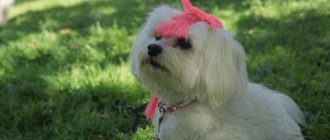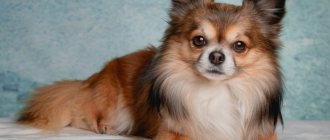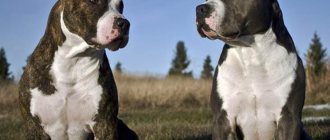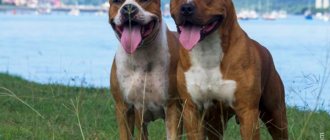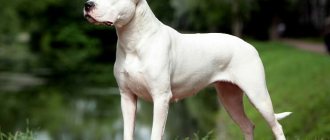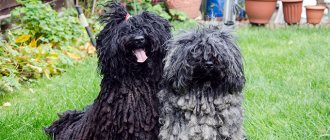According to historical data on the origin of different breeds, fighting dogs do not have a single ancestor. According to the classification, they all belong to the Wolf family and, according to one version, they descended from wolves and jackals. Through selection and production of hybrids, fearless pets were bred, capable of quickly entering into battle, protecting themselves and loved ones, and fighting for their owner.
Dogs took part in gladiator fights, accompanied people on campaigns, and were an integral part of attack tactics and territory protection.
In ancient times, Molossians were valued; in the Middle Ages, bulldogs appeared, then a group of terriers appeared. In the last two centuries, history has allowed the possibilities of interbreeding to expand. Representatives of herding groups and typical hunting dogs joined the fighting dogs.
At the same time, hybrid forms of breeds acquired their final features. This was facilitated by the organization of exhibitions and other events, and the development of special international standards.
There is no single definition of “fighting dog” in the world; it is very conditional. This includes those representatives who, based on their character traits, abilities, learning ability and appearance, are suitable for being allocated to groups.
Dogs are reliable guards and defenders with a special character, where the leading feature is innate aggressiveness. During the selection process, the ability to quickly attack and attack decreased. This does not mean that all Wolfs have turned from fighting pets into good-natured people.
We must always remember that behavioral traits and characteristic features are inherent in many people. How they will manifest themselves, when, why, no one knows. Owners should be properly trained, taking precautions, and suppressing the pet's desire to take a leading position.
Classification of fighting dog breeds
When selecting Volchis for a group, they are still guided by several factors:
- Strong paws, large head and developed jaws.
- The body structure is powerful, allowing it to withstand physical stress.
- Most fighting dogs have close-fitting fur. A specific feature is stretching, which minimizes injuries.
- Basically all breeds are smooth-haired. The exception is dogs, which were originally intended for hunting. Their hair is fluffy, with a rich undercoat.
The classification involves division into groups based on origin. These include:
- bulldogs;
- mastiffs;
- terriers;
- shepherds
There are also representatives who do not belong to any of the groups due to the characteristics of their origin.
Due to different characteristics, they are divided into groups by size (small, medium, large) when the height of an adult dog is determined. Another classification is wool (short, medium, long). Some have several subspecies of wool at once, which allows them to withstand weather loads of varying intensity.
American Bulldog
The American Bulldog breed has been known since the end of the 19th century. The dogs were used mainly on farms: the bulldog drove and killed cattle. Before the ban on dog fighting, the animal took part in bloody “fun”.
Breeding an American bulldog with a pug helped transform it into a different form and acquire qualities such as loyalty and endurance. You need to be attentive to details: the dog has a hunter's instinct and can be aggressive when it smells blood.
Excellent qualities as a security guard and watchman.
The breed is classified as large, males up to 68 centimeters tall, females up to 65 centimeters, weight respectively: up to 60 and up to 50 kilograms.
TOP fighting dog breeds
We present the most popular breeds that are classified as “fighting dogs” based on certain qualities.
Terriers
Terriers are a large group of wolves that were originally bred to hunt animals. Translation from French means “burrowing dog.” These are ancient representatives with a developed instinctive sense, brave disposition, and stubborn character. Among them there are large individuals. Fighting dogs have genes from bulldogs in their blood, which makes them more aggressive.
Bull Terrier
It is distinguished by an interesting skull structure with an elongated muzzle, which smoothly transitions into the forehead with a large bridge of the nose. The eyes are set on the sides. The overall appearance is terrifying. Height reaches no more than 40 cm in males. Compact, well-muscled, bull terriers require constant training. They treat pets and their family well, but they have difficulty getting along with other pets. They are characterized by jealousy, intolerance, and the likelihood of a quick attack without reason.
Staffordshire Bull Terrier
Bred by selection among the best among terriers, molossers and bulldogs as a dog participating in fights. Strong paws and stability help to attack quickly and fight to the last. As selection progressed, the character was softened, but genetically they are real fighters.
Some may find them too cute, but most will agree that the beast is dangerous. They have rich facial expressions, an attentive gaze and a stubborn character. When training, you need to suppress the desire to take leadership positions. These are small dogs that are convenient to keep in an apartment, but they need to go for walks and engage in physical activity due to their tendency to become obese.
American Pit Bull Terrier
Daughter type of Stafford. After dog fighting was banned in England, pit bulls appeared in the United States. They were considered the most improved breed, from whose blood fabulous money was earned. Outwardly they are similar to bulldogs and terriers, but with a more powerful muscular body and strong limbs.
Due to the lack of international standards, there is no clear definition of height. It can reach up to 53 cm, but there are individuals 43 cm. Today it is prohibited in many countries of the European Union and America. They are considered potentially dangerous dogs that show uncontrollable aggression. The owner who is going to raise a pit bull must be aware of the responsibility for the behavior and options for attacking other dogs.
American Staffordshire Terrier
The next generation after pit bulls. It is included in the international register and has the right to participate in exhibitions. With a softer, flexible character, but with fighting qualities. Loyal to the owner and family, amenable to training. The ears are cropped, unlike Stafbulls. Strong, hardy, muscular and stately.
Always ready to fight. Excellent obedience is the result of impeccable work with the owner. The breed is suitable for those who love physical activity and want to have reliable protection for their home and family.
Mastiffs (Molossoids)
Representatives of an ancient group, specially bred for gladiatorial combat, participation in battles, baiting large animals, and long-term pursuit of prey. They belong to the mastiff-like dogs. Outwardly they seem imposing, calm, dependent on a person - this is the result of excellent maintenance. They are naturally endowed with the ability to take part in battles and the ability to stand up for themselves, so they cannot be called a simple breed.
Character of mastiffs
One of the negative traits of Molossoids is stubbornness. You will have to exert maximum patience to overcome the desire to dominate. They are great with children. The owner will constantly feel the presence of the dog nearby. They are sensitive, attentive, inclined to evaluate the world around them, and lazy. They give off a feeling of peace that quickly breaks down alertness.
Molossians have a quick reaction. Its impressive size allows it to lunge and knock down the enemy. The powerful jaw causes wounds. The body is massive with well-developed limbs and strong muscles.
Without proper training, they turn into uncontrollably aggressive dogs capable of attacking without warning.
English Mastiff
The largest of all European mastiffs. Weight more than 100 kg, height up to 75 cm - something that inspires fear and respect. Outwardly it resembles a pug with a dark muzzle and light beige body, paws and tail. The folds and drooping jowls are especially similar, but the nose is more elongated with a large black lobe. Used as baiting dogs. Today they are peaceful guard dogs if raised with love and care.
Bullmastiff
The result of crossing an English mastiff and a bulldog to protect forest lands from robbers. Capable of attacking a person and causing injury (even death). The muzzle is similar to that of a bulldog with deep wrinkles. The body is well developed, muscular, strong. The skull is wide, the ears droop, which are not shortened, like the tail.
His height is about 70 cm and his impressive body allows him to make high jumps and develop fast speed when running. A devoted dog for a family with children, guards and is able to quickly fight in case of danger.
American Bandog
By origin, it is determined by the cross breed of the Neapolitan Mastiff and the American Stafford for night guarding the territory. Not recognized by international canine organizations. On average they reach 40 cm and 45 kg. weight. The coat color is black with a white stripe along the sternum, passing to the stomach. Dark color options are available. The skin stretches well, which helps to avoid severe injuries during battles.
Due to uncontrolled crossbreeding, breeders have never bred a more docile dog. They are cruel, aggressive, and difficult for a dog breeder without experience working with such representatives to handle.
Bully kuta
A rare breed for Europe, it was bred in Pakistan. The literal translation of the name is “heavily wrinkled,” which is due to the typical folds on the muzzle. They are characteristic of molossoids. Height up to 86 cm. The physique is strong and strong. Used for security. They do not tolerate children or other people. They require constant training and intense physical exercise.
Dogue de Bordeaux
French dog for guarding and carrying heavy loads. They have moderate aggressiveness. Bordeaux are distinguished by a red color of the body, limbs and a darker muzzle. The head is large, there are folds on the muzzle, massive jaws. The ears are not cropped.
They tend to treat younger family members with care, provided they are raised. Tolerant of other pets, needs exercise. It became a popular breed after the release of the film “Turner and Hooch,” which showed the peculiarities of dog training.
Ca de bou
A short mastiff designed for baiting hunting. Originally from the Balearic Islands. They were intended for protection and work “in a team” with other animals. They do not try to attack first. They are considered good-natured helpers and protectors of the territory. They never show aggressive traits. They like it when the owner pays attention and care. They respond with gratitude and are well trained.
Cane Corso
Called the pride of Italy. A typical representative of guard, fighting dogs, although at first they were used for driving livestock. Height up to 68 cm, long paws, stately body - something that inspires confidence. The dog looks beautiful, but fierce. They love to be close to humans. They treat other pets favorably, make friends in the “dog playground,” and do not enter into conflicts. They perform excellent search service and protect the territory.
Tosa Inu
A slender torso is not a typical feature for a mastiff. The dog was bred in Japan for protection. Long limbs and a muscular body allow them to withstand physical activity. There are almost no folds on the muzzle, but the general appearance is similar to the group. They are considered a difficult breed to train, when overcoming stubbornness will require enough time and the attentive attitude of an experienced dog handler.
Fila Brasileiro
Slightly smaller in size than the English Mastiff, so similar in appearance that it can be confused. The birthplace of the breed is Brazil. A distinctive feature is the massive numerous folds on the neck due to the structure of the skin. Does not tolerate strangers, immediately shows a negative attitude towards others. For the home, this is a good guard dog that loves its family. Does not like active activities, lazy, unhurried.
Shar Pei
This dog has two distinctive features: many skin folds and a tongue with dark pigmentation. Today it is perceived as a decorative dog, although it is a serious dog with protective qualities. Getting into a fight is a matter of honor for a Shar Pei. They have high intelligence, understand words and gestures, and are trainable. Socialization must begin early, demonstrating the superiority of humans over pets.
Mountain herding dogs
Initially, the breeds were intended to help shepherds. Later, due to their excellent protective qualities and special anger, they began to be used to participate in dog fights, which were nevertheless banned. They are difficult to educate and stubborn. Due to the wool cover, they are resistant to weather changes.
Alabai
Related to Molossians. There have been virtually no modifications in the breed. In ancient times, she took part in gladiatorial battles. Externally it looks like a bear, copes with heavy loads. The torso is powerful with a developed sternum and limbs. Tall growth, thick undercoat, strong grip distinguishes it from its relatives. Growing up is later, so the behavior of puppies and juniors can be traced. It's very difficult to raise. They go into battle without fear, show intolerance towards other breeds, and are difficult to socialize.
Gampr
Armenian wolf dog with a stately exterior. The large size of the dog inspires fear. There is a black mask on the muzzle, sand-colored fur on the body, and a crocheted tail. Like the alabai, they are distinguished by their late maturation. They are devoted to their owner if they feel power and attention. Character is strong and stubborn. They are great with family, but do not tolerate others, especially strangers. Serves as protection and protection.
Caucasian Shepherd Dog
An ancient Caucasian breed with three subspecies, differing in coat length (short, intermediate, long). They are considered representatives of corpulent shepherd dogs for guarding and protecting the home and family. Instinctively able to quickly respond to extraneous sounds and rustles. They treat their family with attention if they feel love and patience. The stately breed requires constant training and plenty of time for walks and games.
Bulldogs
Species representatives appeared by crossing the best subspecies of mastiffs, pugs, and greyhounds. As a result, they were used as hunting animals for baiting animals and as participants in dog fights. Security abilities were later noted. All of them have specific muzzle characteristics: a short, upturned nose, floppy ears, round eyes and short hair.
A group of bulldogs have widely spaced, strong paws. They tend to be overweight, unhurried, and relatively calm. They have a positive attitude towards children and love them, and are considered companion dogs. They love attention and cannot stand excessive severity. They can be aggressive towards other pets.
English bulldog
Appeared earlier than others. He seems to completely repeat the famous stiffness of the inhabitants of Foggy Albion. The height reaches 40 cm. The fur fits tightly to the body, molting goes unnoticed. They are prone to obesity and prefer a sedentary lifestyle. They love leisurely walks. We must always remember that they were traditionally used for baiting animals; they can make aggressive attacks.
American Bulldog
The most serious of all the mixed breeds of the bulldog group. There is no pug blood in it, it is larger and more massive. Constantly subjected to changes to obtain better qualities. The selection of calmer, less aggressive dogs led to the results of the fighting dog becoming a family pet.
Blood from a mastiff reveals a typical representative: a large head, a powerful body and long limbs. They have a special jaw grip. When raising, you need mental stability and firmness. Their intelligence is highly developed. Selection is still being carried out.
French Bulldog
Small size. The height does not exceed 35 cm. High-set ears, an upturned nose, and a flattened muzzle with wings give the dog a comical appearance. The limbs are short, the body is dense. They are able to run fast, catch up with prey, and play. They do not tolerate other Wolfies, they need early socialization. They love children. The character is flexible, but there is a share of stubbornness and willfulness. They are bred as decorative dogs. They are often taken by bulldog lovers to small apartments.
The concept of “fighting dogs” and why it is not entirely correct
The category of fighting dog breeds is not recognized by any cynological organization. This colloquial concept is used only in everyday life, referring to the distant past of some quadrupeds.
Historical reference
England is recognized as the birthplace of dog fighting, although it has been known since the times of gladiators. In the 18th-19th centuries, many bloody tournaments between terriers and bulldogs were held here. Betting on such dubious sports was popular among London's poor.
The most ferocious and courageous dogs were selected to participate in battles. For the sake of victory, breeders focused exclusively on aggression. Four-legged pets were pitted not only against each other, but also against other animals: rats, bulls and bears.
After the ban was introduced, former champions had to be re-educated. Breeders managed to change their character. Most of the bloodthirsty dogs have become completely harmless companions or faithful guards.
Animal format
In the 21st century, fighting breeds include dogs with large dimensions, developed jaws and good endurance. Participation in dog fighting on the part of the ancestors is encouraged, but is not required for inclusion in this group. Because of this, not only terriers and bulldogs, but also molossoids, shepherd dogs and other animals fall under the format.
Please note that not only the concept itself is erroneous, but also its use. Dogs can only be fighting dogs, not fighting dogs like the world famous club. But for the sake of simplicity in this article, both options will appear in it.
Other fighting breeds
Among other dogs, there are those whose fighting character automatically classifies them into the group, but does not distinguish them into a specific subspecies.
Akita Inu
The dog comes from Japan with a high head, long legs and a cute face. Looks like a fox or smiles all the time. An excellent breed for protection, although it looks like a toy. Obedience training should be done by someone who is able to overcome an Akita. They need constant training and classes. If they are bored, they can start a fight and enter into battle.
The increased level of aggressiveness is explained by the dog’s original purpose for hunting and protecting livestock, accompanying people on long journeys. He is friendly with the owner and does not interact well with other dogs.
American Akita
A variety of Japanese Akita Inu with selection in the USA. They are easier to train and have less aggression. Too pleasant an appearance “lulls one’s vigilance.” Compared to their relatives from Japan, they are friendly and are not able to attack first. They obey the owner, protect the family and the territory of residence. They love long training sessions and are easy to train.
Rottweiler
The breed is exclusively for those who can cope with a bad temperament. A wayward dog is capable of lunging, attacking, and chasing. A strong jaw grip can instantly disable an enemy. A powerful body, strong paws and a high level of endurance make the dog a real guard.
The dog is included in the list of dangerous, prohibited breeds in many countries around the world. Requires an experienced canine approach. May show a sudden attack of discontent and break off the leash. It is advisable to carry out walks using a strict collar and a short leash.
Caucasian Shepherd Dog
The age of the breed exceeds two thousand years. In the harsh mountain conditions of the Caucasus, dogs, protecting loved ones, showed all their anger and rage, becoming a living weapon in the path of enemies.
During the development of the breed, Caucasians were strictly selected based on their performance characteristics: excellent and reliable guards, steadfastness in difficult situations, endurance.
The formation of the breed took a long time, its standard changed several times, the last one in 2010.
Modern Caucasians have retained their large size and stern appearance, but unexpectedly have a friendly disposition. Shepherds are confident and not fussy, persistent and fearless. The dogs are highly trainable and get along well with children. Shepherds are distrustful of strangers.
Despite the fact that instinct lays the foundations for the character of Caucasians, the dog needs proper upbringing and training. The owner must have a strong character and perseverance, as well as be demanding of the pet.
The dog needs constant physical activity and training. Weakening the regime can lead to disastrous consequences: the animal may rush at the owner.
The height of males is 72-75 centimeters, weight is 50 kilograms; females reach the following sizes: height 66-69 centimeters, weight - 45 kilograms.
Is it worth getting a fighting dog?
A fighting dog is naturally endowed with traits that are difficult to handle without training. If you decide to get a pet, then consider the following factors:
- Each breed has its own positive and negative traits. You should definitely know them before purchasing.
- The future owner is distinguished by courage, determination, and the ability to make quick and correct decisions.
- A genetic predisposition to aggression can manifest itself at any time: during a walk, when you are exercising, if another dog approaches. Behavior must be constantly monitored.
- War dogs are distinguished by their endurance and mobility. This is supported by regular physical training and long walks.
- Some dogs are prone to obesity and rapid weight gain. This is regulated by proper nutrition.
If you decide to get a fighting dog, you take full responsibility for proper upbringing in an urban environment. Socialization is absolutely necessary, including special obedience classes with dog handlers.
English Mastiff
The ranking of fighting breeds is headed by one of the largest dogs. Just look at the photo and it becomes clear that this is a worthy participant in dog fighting. Moreover, English mastiffs have been seen in the arena of mixed battles, between man and animal. Moreover, despite their formidable appearance and strength, dogs of this breed are distinguished by such traits as affection, patience, gentle disposition (hard to believe), and obedience. Like any other fighting dog, they must be taught commands.
2
How to choose
Puppy or teenager, adult dog differ greatly from each other. Depends on many conditions:
- pedigree;
- purity of breed lines;
- maintenance, parenting.
No breeder will give away a puppy at an early age, without vaccinations. Before purchasing, you should familiarize yourself with the breed offers. Each of them has its own characteristics, which the puppy’s owner is sure to talk about.
You need to know what you eat and how to make your diet more balanced. Prepare in advance for the meeting with your planned pet. Study all the characteristic features, watch videos and photographs.
When buying a puppy or junior, pay attention to:
- on the condition of the coat, which should be shiny, healthy, free from parasites;
- behavior is characterized by activity, playfulness, loud barking at the sight of a stranger;
- a healthy puppy is cheerful, does not itch, does not rub, and has no streaks in his eyes.
An honest seller will put it in an exhibition stand, show the parents (father, mother), talk about successes, features of development, feeding, behavior.
Don't be afraid to ask questions. Try to avoid the temptation to buy cheaper, “cull”. In the future, such a wrong step will affect the development of fighting dogs.
We must remember that there will always be “fashion” for certain breeds. You should not take a dog just because it is prestigious now. The choice must be made with heart, soul and logic. Assess maintenance and care options. This helps to avoid mistakes.
American Bandog
The active development of the breed began in the seventies of the last century. The selection was carried out by an American veterinarian. Bandog (translated as chain dog) is a selection from the pit bull terrier, Staffordshire terrier and Neapolitan mastiff.
The time of bans on dog fighting created other requests for dog breeds - home security, watchdog work, companions for active owners.
Bandog does an excellent job of protecting farms from small pests; he is an excellent security guard and bodyguard. In addition, there are requests for the Bandog breed to work in law enforcement agencies.
Only an experienced dog breeder can become the owner of a bandog. The owner will need to make efforts to manage the difficult character of the strong-willed pet.
The main feature of dogs is their developed protective instincts; bandogs can distinguish a person’s comic games from his evil intentions. For example, when breaking into an apartment, the bandog will not bark and give away its presence, but a thief who has entered the apartment will not be able to leave. Cases of tragic reprisals against thieves have been recorded.
Bandog is a large breed of dog, weight varies from 40 to 65 kg and height at the withers from 65 to 73 cm. Males gain the maximum size and weight.
Briefly about the main thing
- The Fighting Dog differs from other Wolfdogs in its ability to immediately enter into battle for itself or others, to protect its home, territory, family.
- Most breeds are characterized by stubbornness and disobedience. It is genetically embedded in them and is inherited.
- All breeds require attention and activity, constant training and long walks in the fresh air.
- Each representative has its own characteristics that need to be studied before deciding to purchase a puppy.
- You cannot buy from unknown breeders in order to avoid damage to the breed and excessive aggression when growing up.
- The owner is obliged to study the principles of canine training in the behavior of fighting dogs and bear full responsibility for the correct approach to the pet without cruelty, with patience and attention.
Shar Pei
Looking at small Chappei puppies, it’s hard to believe that they are aggressive, but it’s true. The breed is considered one of the ancient fighting breeds. Considering that malice and toughness were lost during the selection process, it is no coincidence that experts say that Shar-Peis need to be trained to participate in battles from an early age. Otherwise, the dog will not be able to demonstrate courage.
13
Staffordshire Bull Terrier
The ban on dog fighting prevented the use of representatives of this breed in such activities. However, there are still underground fights where, at the sight of an opponent and blood, bull terriers demonstrate aggressiveness and bloodthirstiness. Fighting to the last drop of blood is just about them. At the same time, dogs are trained well and quickly.
15
Dogo Canario
As the name implies, the breed originated in the Canary Archipelago from crossing local dogs with Molossians. This is a fairly balanced dog, although it is prohibited from being imported into a number of countries.
The somewhat phlegmatic-looking Dogo Canary will readily take a decisive pose and show considerable swiftness for play or exercise. Since their nervous system is in perfect order, they usually don’t start fights, but if someone catches a Great Dane, the unfortunate bully won’t care.
Some people are afraid of the Dogo Canario breed, but in most cases, the dog’s inappropriate behavior is the result of inadequate upbringing. Yes, there have been fatal cases involving people, but a properly socialized dog will never attack a person unless provoked.
This smart breed takes training easily, but in order to raise a dog that is safe for others, you need to take specialized courses.
This is a one-owner dog, so there must be a clear leader in the human family. Otherwise, the dog will realize that there is no commander in chief and will do as he pleases.
Video: Dogo Canario
Toy Terriers
The last type of terrier in the official classification is the toy variety.
Yorkshire Terrier
A decorative terrier dog that has received the greatest recognition in the world. It is impossible not to love these sweet companions, because they become attached to their owners from the first day. Yorkies are active, inquisitive, restless, and love to communicate. Based on height, there are three types of individuals: standard, mini and super-mini. The price of a puppy starts from 15,000 and goes up to 60,000.
Australian Silky Terrier (Silky)
A stocky dog with fine silky hair, the length of which reaches 15 cm. The height of an adult is 23 cm, weight - 5 kg. Silky is considered a good-natured companion: he takes training well, obediently follows commands, and loves affection. But the dog is not averse to fighting with its relatives, so the upbringing must be correct. Puppies are sold for 15 thousand rubles or more.
English toy terrier
A rare species with an elegant build and miniature dimensions (height 25-30 cm; weight 3.5 kg). The temperament of individuals is peculiar, but not capricious. The price starts from 30,000 rubles.
Gampr (Armenian Wolfhound)
This breed is quite large and looks powerful, its height is about 64-68 centimeters, but there are specimens that are about 90 centimeters. The dog's weight varies between 49-64 kilograms, a significant part of it falls on the wool. The muscles are well developed, the body is quite massive, the chest is wide. The ears hang down, the eyes are dark, there are sloping brow ridges, making the look look friendly. The color of this breed varies, most often it is sandy, but the muzzle is always black or gray. The coat is long, the tail does not lie on the back even in a state of excitement.
Gampr is a kind and caring dog, she does not like fuss and clearly follows commands. She usually shows a reverent attitude towards children and remains neutral towards other animals. The dog behaves calmly during training and appreciates encouragement.
to contents ^
Jagdterrier
Nobility and courage are about them.
- Height: 33-40 cm for a male; 28-35 for a female
- Weight: 8-10 kg.
- Lifespan: 13-15 years.
- Color: black, dark brown or grey-tan.
- Coat: medium length, thick. Densely laid over thick undercoat.
Did you know? In 1995, a “dog” record for the length of the swim was set. Labradors Gypsy and Kai, accompanied by their owner, swam 15.2 km (it took 6 hours).
They are easy to train and train, which should be done regularly. Long walks with elements of play (bring a stick or ball) are required, without which the dog will become lethargic or show destructive tendencies.
This terrier will get bored in an apartment, so it is better to keep it while living in your own home. By the way, children will not be the best companions for them (although dogs accept them as “their own”, rushing to help if necessary).
Favorite location is a field where you can chase trophies without restraint, which often ends in a direct fight (brave “yagdas” are not afraid to attack).
Health and illness
The American Stafford is in excellent health , active and resilient. A dog's well-being can be judged by a wet nose, clear eyes, excellent appetite and the absence of an unpleasant odor. The onset of the disease is indicated by poor appetite, reluctance to play, go for a walk, apathy and indifference.
Characteristic diseases
- Hip dysplasia . Many large dogs suffer from this disease. Its occurrence is associated with improper diet, intensity of physical activity, and genetic predisposition.
- Bloating . Occurs when digestion is disrupted and requires a change in diet.
- Allergic reactions caused by various irritants.
- Eye diseases (development of cataracts, retinal atrophy), etc.
If you contact a veterinary clinic in a timely manner, you can cure any disease or, in extreme cases, minimize the consequences of the disease. Proper care and good living conditions will ensure a life expectancy of 12–15 years .
Vaccinations
Before giving preventive vaccination to puppies or adult dogs, mandatory deworming . Vaccinations can be monovalent (against a specific disease) or polyvalent (complex).
Vaccination will prevent the occurrence of many dangerous diseases : infectious hepatitis, canine distemper, rabies, leptospirosis, etc.
Do not forget to carry out antiparasitic treatment. You can get rid of ticks and fleas using drops on the withers, sprays, special shampoos and collars.
Raising a puppy
The Bull Terrier is a hyperactive dog, so you need to start training your puppy from the first days of his arrival in your home. The new resident should have a place to rest, a designated place for food, where there should be bowls for food and water.
View gallery
First of all, the owner must make it clear to the baby that he is the master of the house. You cannot follow the puppy’s lead, allowing him to climb onto the sofa or beg at the master’s table. Small bull terriers are very smart. They quickly understand that they cannot take food from strangers or pick it up from the ground, etc. If you understand that you cannot raise a puppy on your own, contact a professional dog trainer.
